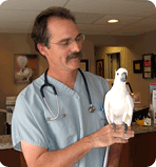Sick Patagonian conure - again

Dr. Speer, first of all, thank you for making yourself available to us. We appreciate it. Secondly, I have a question regarding my 15 year old patagonian conure, Luther. He’s an adoptee and I’ve had him about 5 years. He’s had recurrent sinus infections ever since I adopted him. I’ve had him to 3 different vets in my area and he’s almost always on Baytril or some other antibiotic. In November of this past year I took him to a new vet and had lab tests done.They came back within normal limits except for these: Albumin LOW at 1.1 (Normal 1.2-3.2), Glucose HIGH at 381 (180-350), Potassium HIGH at 5.3 (3.0-4.5), and Chloride HIGH at 116 (90-110). Choanal cultures came back with a heavy growth of Coagulase negative taphylococcus spp. and a light growth of Pseudomonas aeruginosa. Sensitivity tests showed both to be sensitive to Baytril. He was put on Baytril again but within a few weeks he began having brown drainage from his nares, so I took him to a
different, actually his original, vet who is the only Board Certified Avian Vet of the three. He told me to hold the antibiotics for 3 days, then repeat the cultures, which was done. He also took an xray of Luther’s chest. It showed an huge granuloma in the area of his syrinx. After testing Luther was started on sulfatrim (doxycycline, I believe) but continues to show symptoms that the granuloma is not diminishing because he makes wheezing sounds and his voice is hoarse compared to what it normally is. The vet told me on that visit that granulomas were almost impossible to get rid of. He also mentioned a procedure whereby he could remove some of the lesion which would also require putting an opening in one of his air sacs. (I have lost 2 birds this past year and am loathe to have this surgery done because I fear it will not go well. They were both elderly but I am still afraid for Luther since he’s been ill so much.) So now Luther is getting the sulfatrim, fluconazole, and nebulization therapy twice a day with normal saline. But he still wheezes and has a hoarse voice. Once he finishes the antibiotics I am thinking the vet will want to do another xray, but am not sure. I wanted to ask your opinion. Also, are you
available for a phone consultation regarding this?

Cindi - it is probably a bit unethical for me to be making specific medical recommendations for your bird in this type of a forum, with the amount and number of veterinarians that have had specific hand’s-on evaluation of him, whereas I have not. Always remember, however, that it is fair to ask your attending veterinarian to consult with another colleague, or to provide radiographs and medical records so that you can have them independently reviewed. This is something that we do at our practice on a daily basis for many bird owners and colleagues around the globe. But, we still are limited in that we cannot see, hear and actually handle the bird, and as such, can only consult from the side about what may or may not be present, what may or may not be significant, and what may or may not be appropriate to consider and/or do. The laboratory “abnormalities” you have mentioned are actually within acceptable normal limits, in my eyes, and those changes are likely insignificant. What I do not see, however is the recorded physical examination and the remainder of what WAS evaluated and deemed to be normal. Remember that choanal culture isolates do not necessarily have to equivocate to actual infectants in many ill birds, and it may be unfair to assume that these isolates are responsible for what you are assuming to be a granuloma in the area of your bird’s syrinx. Many actual syringeal infections require specific endoscopic visualization for diagnosis and confirmation of their etiology - a procedure that I suspect may have been discussed with you. Overall, however, most syringeal granulomas that we see in parrots here typically are minimally evident on radiography, and one would have to wonder if this noted soft tissue density is actually outside the syrinx and pressing on that location, causing similar clinical signs too. There are, unfortunately, a number of tumors that are described in parrots in this location, producing significant vocal changes and clinical disease - but not necessarily a “granuloma” per-se. I would forward that many granulomatous disease processes can be treated successfully, depending on what their identified cause turns up to be, the manner of treatment, and their specific location in the patient at hand. At the risk of being inappropriate in this forum, you can find our practice website and contact phone numbers if you search Medical Center for Birds, should you be interested in a more detailed consultation here. The striking things here in my mind here remains: 1) the need for a bit more accurate diagnosis, 2) hopefully resulting in more accurate treatment options, 3) and a need to investigate the most optimal means with which to address the comfort of your bird, regardless of what the nature of the diagnosis turns up to be.(as well as along the path of obtaining this information)

































